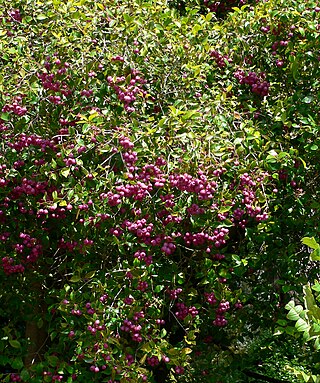
Syzygium smithii is a summer-flowering, winter-fruiting evergreen tree, native to Australia and belonging to the myrtle family Myrtaceae. It shares the common name "lilly pilly" with several other plants.It is planted as shrubs or hedgerows, and features: rough, woody bark; cream and green smooth, waxy leaves; flushes of pink new growth; and white to maroon edible berries. Unpruned, it will grow about 3–5 m (9.8–16.4 ft) tall in the garden.

Pittosporaceae is a family of flowering plants that consists of 200–240 species of trees, shrubs, and lianas in 9 genera. Habitats range from tropical to temperate climates of the Afrotropical, Indomalayan, Oceanian, and Australasian realms. The type genus is Pittosporum Banks ex Gaertn.

Pittosporum is a genus of about 200 species of flowering plants in the family Pittosporaceae. The genus is probably Gondwanan in origin; its present range extends from Australasia, Oceania, eastern Asia and some parts of Africa. Citriobatus can be included here, but might be a distinct genus. They are commonly known as pittosporums or, more ambiguously, cheesewoods.

Ulmus alata, the winged elm or wahoo, is a small- to medium-sized deciduous tree endemic to the woodlands of the southeastern and south-central United States. The species is tolerant of a wide range of soils, and of ponding, but is the least shade-tolerant of the North American elms. Its growth rate is often very slow, the trunk increasing in diameter by less than 5 mm per year. The tree is occasionally considered a nuisance as it readily invades old fields, forest clearings, and rangelands, proving particularly difficult to eradicate with herbicides.

Hymenosporum is a monotypic genus in the family Pittosporaceae. The sole included species is Hymenosporum flavum, commonly known as native frangipani, which is a rainforest tree native to New Guinea, Queensland and New South Wales. Despite its common name, it is not closely related to the frangipani, but is related to the widespread genus Pittosporum.

Pittosporum tenuifolium is a small evergreen tree endemic to New Zealand – up to 10 m (33 ft) – commonly known as kōhūhū and black matipo, and by other Māori names kohukohu and tawhiwhi. Its small, very dark, reddish-purple flowers generally go unnoticed, and are scented only at night. The Latin tenuifolium means "slender-leaved"

Monodora myristica, the calabash nutmeg, is a tropical tree of the family Annonaceae or custard apple family of flowering plants. It is native to Angola, Benin, Cameroon, the Central African Republic, the Democratic Republic of the Congo, Equatorial Guinea, Gabon, Ghana, Guinea-Bissau, Ivory Coast, Kenya, Liberia, Nigeria, the Republic of the Congo, Sierra Leone, Sudan, Tanzania, Togo and Uganda. In former times, its seeds were widely sold as an inexpensive nutmeg substitute. This is now less common outside its region of production. Other names of calabash nutmeg include Jamaican nutmeg, African nutmeg, ehuru, ariwo, awerewa, ehiri, airama, African orchid nutmeg, muscadier de Calabash and lubushi.
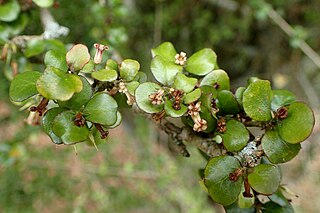
Pittosporum obcordatum, commonly called heart-leaved kohuhu or heart-leaved kohukohu or kohukohu, is a species of plant in the Pittosporaceae family. It is endemic to New Zealand, and exists both in North Island and South Island.

Pittosporum eugenioides, common names lemonwood or tarata, is a species of New Zealand native evergreen tree. Growing to 12 m (39 ft) tall by 5 m (16 ft) broad, it is conical when young but more rounded in shape when mature. Its leaves are mottled yellow-green with curly edges and a salient bright midrib, and have a strong lemony smell when crushed. It has highly fragrant clusters of attractive yellow-cream flowers in spring, followed by distinctive black seed capsules. It is found throughout New Zealand's North and South Islands along forest margins and stream banks from sea level to 600 m (1,969 ft). It is New Zealand's largest Pittosporum.

Melaleuca viminalis, commonly known as weeping bottlebrush or creek bottlebrush, is a plant in the myrtle family Myrtaceae, and is endemic to New South Wales, Queensland and Western Australia. It is a multi-trunked, large shrub or tree with hard bark, often pendulous foliage and large numbers of bright red bottlebrush flowers in spring and summer. It is possibly the most commonly cultivated melaleuca in gardens and its cultivars are often grown in many countries.
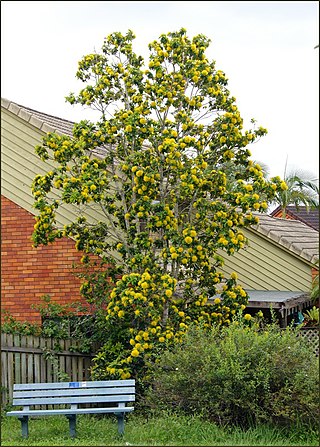
Xanthostemon chrysanthus, commonly known as golden penda, is a species of tree in the myrtle family Myrtaceae which is endemic to north eastern Queensland, Australia. It is a popular garden plant with showy yellow blooms, and is the floral emblem of the city of Cairns.
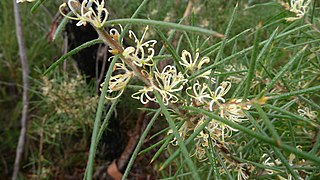
Hakea gibbosa, commonly known as hairy hakea or needlebush hakea, is a shrub of the family Proteaceae, and is endemic to south eastern Australia. It has very prickly foliage, cream-yellowish flowers from April to July, and provides shelter for small birds. It has become an environmental weed in South Africa and New Zealand, where it had been introduced for use as a hedge plant.

Pittosporum erioloma grows as a shrub or small tree. It is also known as the Lord Howe Island pittosporum or hedge laurel, though it is not a member of the laurel family.

Pittosporum angustifolium is a shrub or small tree growing throughout inland Australia. Common names include weeping pittosporum, butterbush, cattle bush, native apricot, apricot tree, gumbi gumbi, cumby cumby, meemeei, poison berry bush, and berrigan.
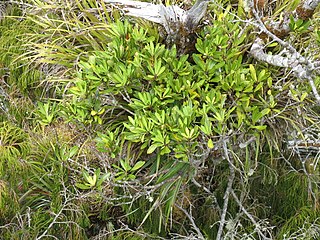
Pittosporum kirkii is a glabrous evergreen perennial shrub that reaches up to 5 metres (16 ft) in height and possesses distinctive coriaceous, fleshy, thick leaves. It is one of four shrubs endemic to New Zealand that frequently displays an epiphytic lifestyle. P. kirkii is commonly epiphytic, perched amongst nest epiphytes in the canopies of emergent or canopy trees in old-growth forest; however, it can be observed occasionally growing on the ground or over rocks. Kirk first observed P. kirkii on Great Barrier Island. It was described by Joseph Dalton Hooker from material collected by Thomas Kirk, possibly from the Thames Goldfields, and published in 1869. The initial brief description titled Pittosporum n. sp.? by Thomas Kirk was published in his paper on Great Barrier Island in 1868. This description along with herbarium specimens were sent to Dr. J. D Hooker at Kew Gardens in 1868, and he collaborated to name it after T. Kirk, by giving it the specific epithet kirkii within the publication that was otherwise written by Kirk.
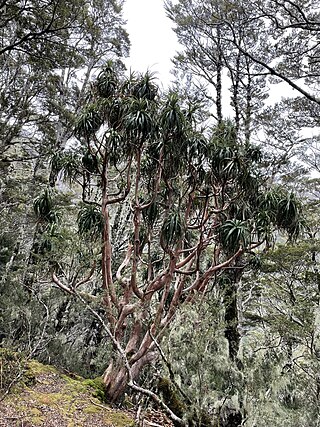
Dracophyllum traversii, commonly known as mountain neinei, grass tree, and pineapple tree is a species of flowering plant in the heath family Ericaceae. It is a deciduous tree endemic to New Zealand. It reaches a height of 0.2–13 m (0.66–42.65 ft) and has leaves which form tufts at the end of its branches. It has a lifespan of between 500 and 600 years.

Dracophyllum elegantissimum, commonly known as grass tree or slender dragon tree, is a flowering plant in the family Ericaceae. Endemic to New Zealand, it is found in the north of the South Island, in north-west Nelson.

Pittosporum ferrugineum, commonly known as the rusty pittosporum or rusty-leaved pittosporum, is an evergreen plant in the family Pittosporaceae native to Malesia, Papuasia, the Northern Territory and Queensland.
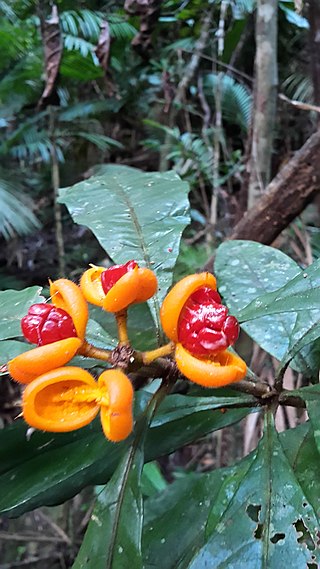
Pittosporum rubiginosum, commonly known as hairy red pittosporum, is an evergreen shrub in the family Pittosporaceae which is endemic to northeastern Queensland, Australia.




















